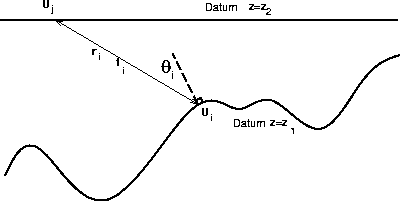Berryhill 1979 gives the following expression for the upward continuation of a scalar wavefield:
| |
(1) |
For a wavefield transformation from one datum U(x,z=z1 ,t) to another U(x,z=z2 ,t) (Figure 1) the discretized form of equation (1) is a summation. Each individual trace Uj (t) comprising U(x,z=z2 ,t) is calculated by performing the sum:
| |
(2) |
|
datumfig2
Figure 1 Geometry for the continuation of a wavefield between an irregular topography and a planar datum. |  |
Equations (1) and (2) are used for upward continuation.
For downward continuation
the conjugate process is used. The sum is performed first
and then the output traces
are crosscorrelated with the ![]() filter described in the Appendix.
filter described in the Appendix.
The program for upward and downward continuation is illustrated by the following pseudo-code:
loop over j {
loop over i {
shift = time shift between input and output trace
if ( conj != 0 )
Q = down [convolve] filter
loop over time {
if ( conj == 0 )
Q(time-shift,i) = Q(time-shift,i) + up(time,j)
else
up(time,j) = up(time,j) + Q(time-shift,i)
}
if ( conj == 0 )
down = up [crosscorrelate] filter
}}
The notation in the pseudo-code is consistent with Figure 1. The data on the upper datum z=z2 corresponds to index j and the data on the lower datum z=z1 corresponds to index i. For conj!=0 the data are upward continued from down to up and for conj==0 the data are downward continued.
The actual code used to perform the datuming in this paper is complicated by calculation of geometrical parameters which arise due to non-planar datums and by the incorporation of anti-aliasing. Since the datuming algorithm is based on an integral equation solution it is susceptible to operator aliasing. This is taken care of by calculating triangular smoothing functions along the operator trajectory in a manner analogous to Claerbout 1992.